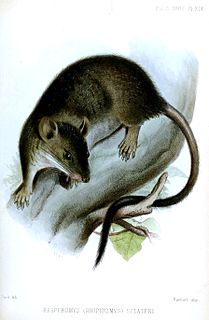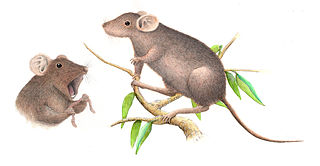The Andean rat, or white-tailed akodont, is the only species in the genus Lenoxus. It is a rodent in the tribe Akodontini found on the eastern slopes of the Andes of eastern Peru and western Bolivia. Examination of its genome shows that this species is not closely related to Oxymycterus as had previously been thought, but is quite distinct, having diverged from the other Akodontini soon after the basal radiation of the entire group.
Gardner's climbing mouse is a rodent species from South America. It is found in western Brazil, southeastern Peru and northeastern Bolivia. It is an uncommon, arboreal species, but faces no particular threats so the International Union for Conservation of Nature has rated it as being a "least-concern species".

The white-footed climbing mouse is a species of South American rodent found in Bolivia, Brazil, Ecuador, French Guiana, Guyana, Peru, Suriname and Venezuela. It is the type species of the genus and the type location was the lower eastern slopes of the Andes in central Peru.

Rhipidomys is a genus of rodents in the family Cricetidae, The following 24 species of climbing mouse species are currently recognised:
Abrothrix illuteus, also known as the gray akodont, gray grass mouse, or gray soft-haired mouse, is a species of small rodent in the genus Abrothrix of family Cricetidae. It is found only in northwestern Argentina.

Abrothrix longipilis, also known as the long-haired grass mouse or long-haired akodont, is a species of rodent in the family Cricetidae. It is found in central and southern Argentina and Chile. The southern Chilean Abrothrix sanborni may not be distinct from this species.

The large Mindoro forest mouse is a species of rodent in the family Muridae, from the genus Apomys. It is found only in the Philippines. Its natural habitat is subtropical or tropical moist montane forests. It is a large mouse with large feet, a long tail and an elongated snout which is morphologically unique within its genus. It is covered in soft fur which is mostly dark brown in colour. Its closest relative is thought to be the Luzon montane forest mouse, based on genetic and morphological similarities.
The pleasant bolo mouse, or pleasant akodont, is a species of rodent in the family Cricetidae. It is found on grassland at high altitudes in Bolivia and Peru.
The rufous-bellied bolo mouse or white-chinned akodont, is a species of rodent in the family Cricetidae. It is found in Argentina and Bolivia where it inhabits the dry valleys of the eastern Andes. Its conservation status is listed by the International Union for Conservation of Nature as being of "least concern".
The dark bolo mouse or dark-furred akodont is a species of rodent in the family Cricetidae. There are two subspecies; one is found in eastern and central parts of Buenos Aires Province, Argentina, and the other in coastal areas of southern Uruguay.
The montane hylomyscus or montane wood mouse is a species of rodent in the family Muridae. A long-coated species with brownish-grey upper parts and whitish-grey underparts, it occurs in the uplands of tropical Central Africa where its natural habitat is tropical moist montane forests.
Irenomys tarsalis, also known as the Chilean climbing mouse, Chilean tree mouse, or long-footed irenomys, is a rodent found in Chile, from about 36° to 46°S, and in adjacent Argentina, mainly in forests. It is a large, long-tailed, soft-furred mouse characterized by grooved upper incisors and specialized molars with transverse ridges, divided by deep valleys, which are connected by a transverse ridge along the midline of the molars.
Oligoryzomys destructor, also known as Tschudi's colilargo or the destructive pygmy rice rat, is a species of rodent in the genus Oligoryzomys of family Cricetidae. It is found along the eastern Andes from southern Colombia, through Ecuador, Peru, and Bolivia into northern Argentina. Its karyotype has 2n = 60 and FNa = 76.

Oligoryzomys longicaudatus, also known as the long-tailed colilargo or long-tailed pygmy rice rat, is a species of rodent in the genus Oligoryzomys of the family Cricetidae. It is found in the southern Andes of Chile and Argentina, with an outlying population in eastern Argentina. As a common species with a wide range and a stable population, the International Union for Conservation of Nature has rated this rodent as being of "least concern".
Coues's climbing mouse is a species of rodent in the family Cricetidae. It is found in Colombia, Ecuador, Peru, Trinidad and Tobago, and Venezuela. It is named in honour of the American zoologist Elliott Coues who studied birds and small mammals.
The golden Oldfield mouse or golden thomasomys is a species of rodent in the family Cricetidae. It is found in Colombia, Ecuador, Peru, and Venezuela. Both the common and genus name commemorate the British zoologist Oldfield Thomas who worked at the Natural History Museum, London and studied South American rodents.

The Cinderella fat-tailed mouse opossum is a species of opossum in the family Didelphidae. It is found in northern Argentina and southern Bolivia, in the eastern foothills of the Andes. Its dorsal fur is gray brown to dark brown. Its ventral fur is gray-based, except for the white to yellowish chest hairs. It has been distinguished from T. sponsorius by the well-developed postorbital ridges of the latter, but mitochondrial DNA sequence analysis does not support separate species status for sponsorius.
The cerrado climbing mouse or long-tailed rhipidomys is an arboreal rodent species in the family Cricetidae from South America. It is found in primary or secondary forests of the cerrado and caatinga in central and eastern Brazil, and has also been seen in the Atlantic Forest. Its karyotype is 2n = 44, FN = 48-52. They are nocturnal animals and can be found in both tree canopies and on the ground.
The long-tongued arboreal mouse is a South American rodent species of the family Cricetidae. It is found in a variety of habitats, including dense forest, in Bolivia and Peru at elevations from 450 to 2,100 metres on the eastern side of the Andes. The species is at least partly arboreal. It is distinguished from the Brazilian arboreal mouse, the only other known member of Rhagomys, by spiny fur and certain skull features such as the presence of beading in the interorbital region.
The Peruvian climbing mouse or lesser Peruvian rhipidomys, is a South American species of rodent in the family Cricetidae. It is endemic to the eastern slopes of the Andes in central Peru, where it is found at altitudes from 700 to 1,800 metres. The species is nocturnal and arboreal, and lives in lower montane forest and cloud forest. It is threatened by forest clearance for agriculture and coca cultivation but is listed as a "least-concern species" by the International Union for Conservation of Nature.






